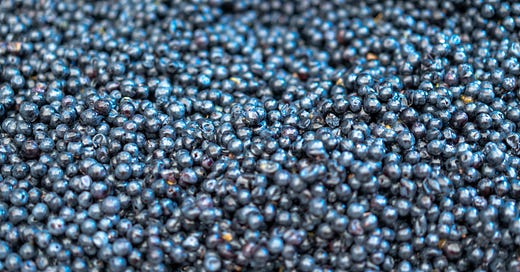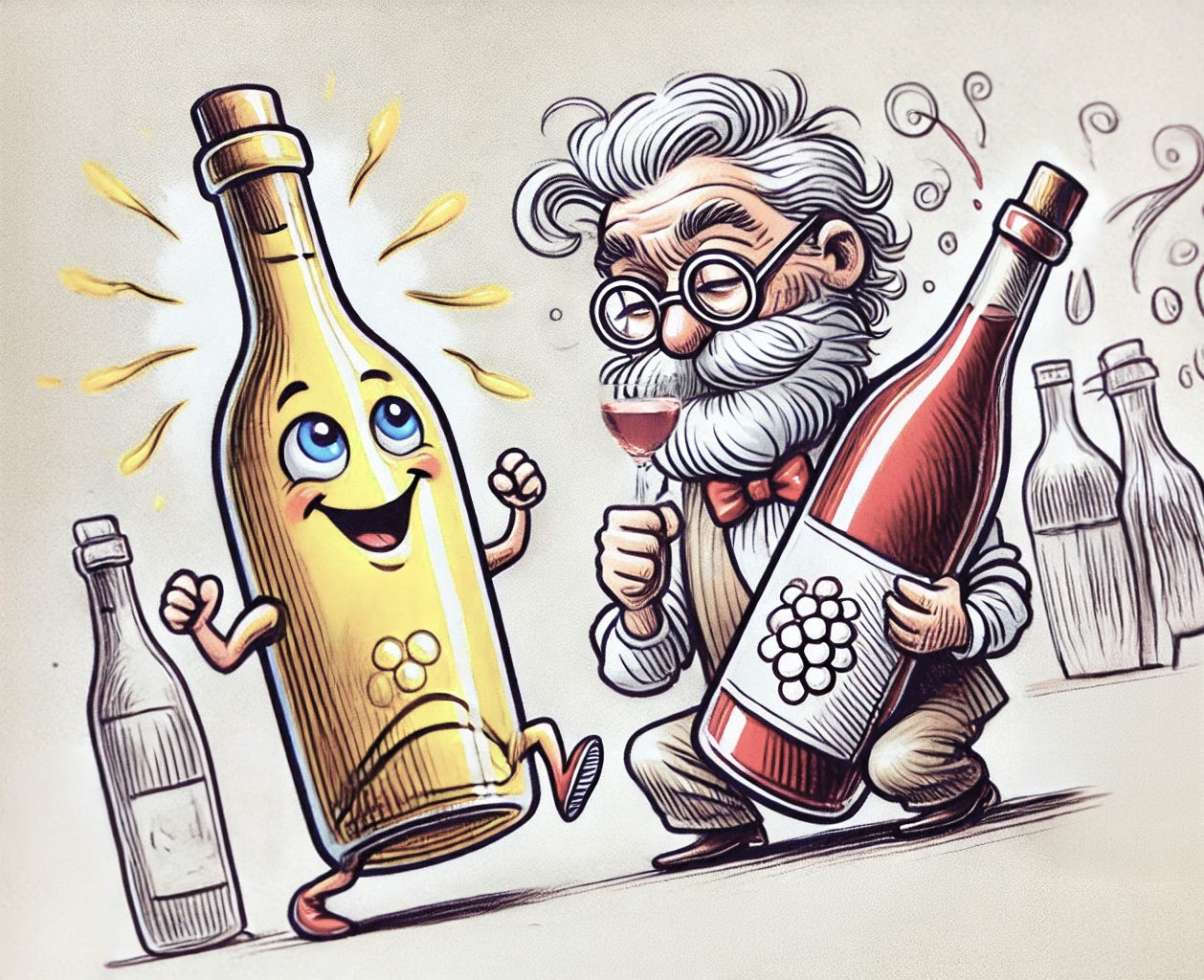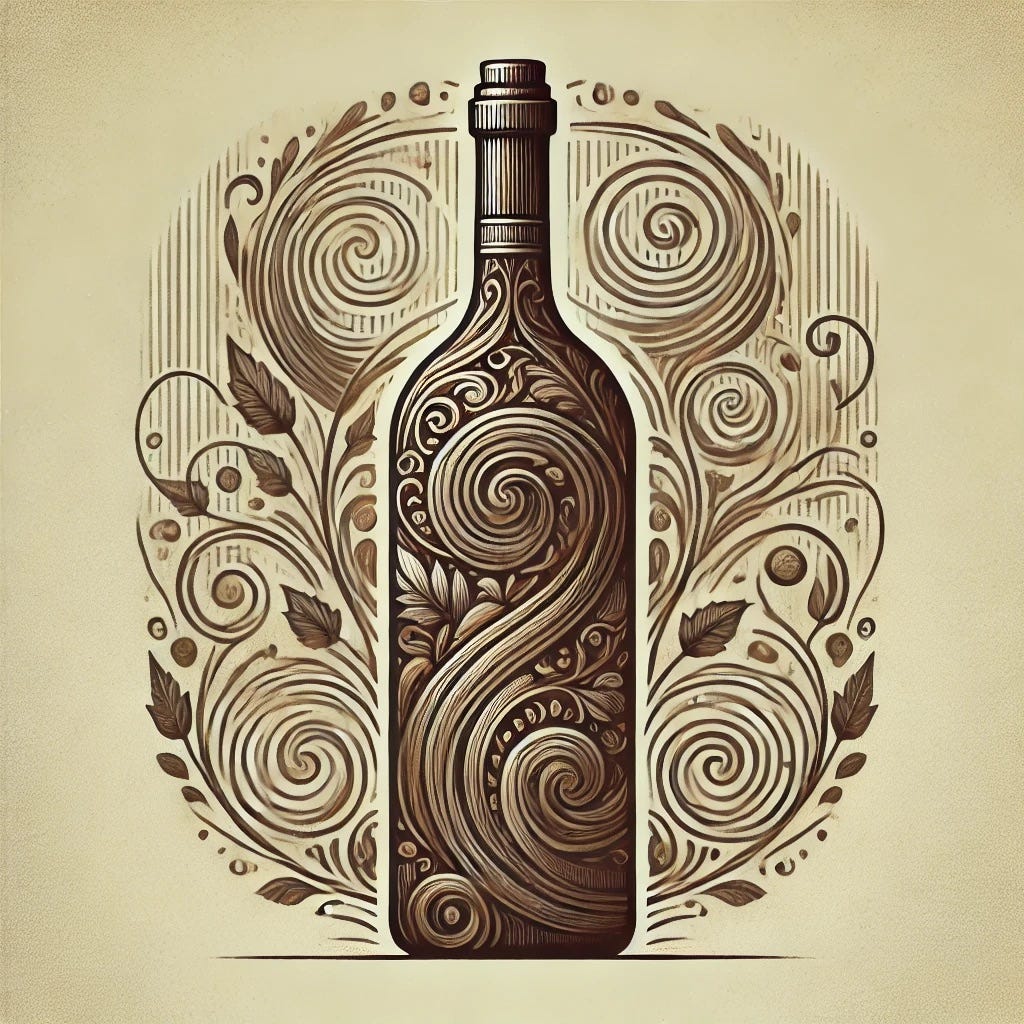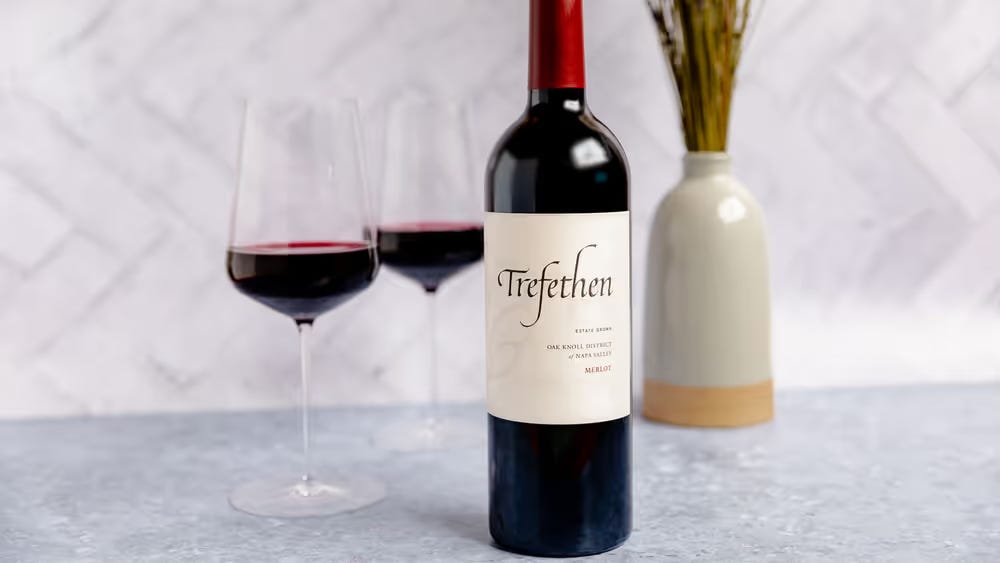NAPA VALLEY, Calif. — There is an undeniable freshness and vitality to most very young wines, particularly white and rosés that display charming, often tropical or fruit-driven aromatics that deliver sprightly acidity that’s tasty when chilled.
Far less widely appreciated, however, especially in the world of the finest wines, is a character trait that decades ago was not only paramount in terms of wine appreciation but also was esteemed for its ability to reveal secondary and tertiary elements that young wines could never hope to display. And it is that very trait that has, over the last several decades, not only lost its broad esteem, but also has been disappointingly disparaged by the uninformed.
Key Points
Young wines are appreciated for their freshness and vibrant, fruit-driven aromas.
The emphasis on aging wines has diminished in recent decades.
Fine wines need time to develop complexity and maturity.
Even whites and rosés benefit from some aging.
Proper aging allows wines to develop complex aromas and flavors.
Wines vary in optimal aging periods, from a few years to several decades.
Aging enhances balance, structure and overall enjoyment.
Historical examples of aged wines showcase unique and complex characteristics.
Balance and high acidity are crucial for wines to age well.
It is age. Or maturity. Or development. Or character. Even wisdom. Historically, society has routinely paid lip service to “fine, old wine.” But for some reason the concept has been thrown under the bus in the last few decades. Iconic young cabernet sauvignons that receive extremely high scores and command extremely high prices are regularly purchased eagerly, corks pulled with alacrity. Patience may be a virtue, but it does not seem to be a character trait that has impacted many of those people who buy expensive cabernets.
So eager are the acquirers to try the hundred-point exalteds that they forget (if they ever knew) that a fine wine needs to have some time in the bottle to develop some of its characteristics.
I learned this graphically in the last two years. When I chose to make a small amount of dry riesling in 2022, I knew I would be making a wine that would not be ready to drink for at least two years. Two years are up, and I opened a bottle a few days ago. It has become fascinating and far more complex than it was soon after it was bottled, but it is still at least a year or two from where it is headed. It may be better in a decade.
This happens with most fine wine. Even those whites and rosés mentioned above can benefit from a little more time following release.
Although it has been difficult in the last two decades to find red wines that will age well, the benefits certainly are evident when you taste a wine that has evolved from its brash, youthful state to one of sublime charm. Some youthful whites might lose a slight touch of their spry vitality of aroma, but usually what is gained is worth the trade-off.
Maturity in red wines is usually far more beneficial than drinking it young. When you pull a foul-looking cork from a well-matured bottle of a fine red and allow the wine to gain some measure of oxygen that breathes life back into its soul, you may well see how Mother Nature and Father Time conspired.
That first un-aerated whiff may well be closed-up. The wine may have needed a few minutes, even decanted, to regain its equilibrium and begin to show some semblance of what a great wine can be when it is mature. I’ve often heard winemaker friends say of a newly released red, “It’s not wine yet.” Some such bottles are merely alcoholic grape juice.
This indicates that the wine’s producer understood not only that wine is a living thing that goes through many stages but also that its peak will probably be a bit later than a year or two.
Some wines are best when they are 2 years of age; others are best five years after the vintage. A few, not many, will go 25 to 30 years. Wines age on a curve that starts out with them tasting awkward, then improves for a time. Eventually they decline. The percentage of wines that can deliver much joy at 30 years is so small as to be nearly zero.
The number of wines that can age a long time has dwindled consistently over the last two decades. But today most wines need some time to appreciate. Notably, some wines with screwcaps can be so undeveloped when they are young that airing them (even whites) can be beneficial.
When you reach that stage in a wine’s life in which it has aged long and carefully enough for it to have developed secondary aromas and tastes, it is only then that you can really see the glories of mature wine. At that stage, when a wine has transmogrified into a near diaphanous state, we can see that the fruit plays a much lesser role than as a young pup – but it is still a vibrant role. Sometimes a white wine’s greatest asset is not in fruit but in what I call minerality.
As the colors of all wines change (reds lighten, whites darken), so do the fruit aromas and tastes. Great wines have more staying power, not because of any early approachability but because they were made to be better in time with good acidity. That almost guarantees that their early scores should be based on issues other than aroma and taste.
Perhaps the world’s greatest aging red wine is Barolo. Great houses in Bordeaux also make age-worthy wine, but lesser houses often come up short here. Other wines that can be glorious with age include carefully made cabernets, red and white Burgundy, port and a number of dessert wines that are fortified. The best red Rhônes and many Australian reds live for decades. And don’t forget Australia’s Hunter Valley semillons, many German rieslings and even some Riojas of Spain.
Some of the most sublime older wines in history have been sweet dessert wines, including German rieslings and French sauternes — even though some of these products eventually will turn dark brown over time. Despite the loss of color and fresh-fruit aromas, the clear benefits of age are aromas that relate to poached apricots, peaches, honey and occasionally caramelized scents. Included are late-harvest semillons, vintage ports, Hungarian Tokajis, vendange tardive whites from Alsace and Rutherglen muscats from Australia.
Many such wines, when young, display little of their eventual charms—and when they reach a point where they really do deliver mature greatness, most newcomers to the experience rarely appreciate them on first sip. What is required for such wines to make it to the peak of maturity is supreme balance that leans on high acids that will keep the wine in good shape over time.
Some of my favorite sweet wines in the world are the ice wines from Ontario, Canada. These wines are unbelievably sweet, but almost all of them are so perfectly balanced with extremely high acidity levels that they almost never come across as cloying. Unfortunately, the Canadian wineries that make these fabulous products are not encouraged to sell them outside of their own region, but you can get them if you visit Canada – a compelling reason for wine lovers to consider a vacation there!
Lacking balancing acid levels, any wine (including most fortified dessert wines) may well have a lovely aroma and bouquet when old but could also show evidence of a lack of balance that robs it of the ability to deliver charms worth drinking. Any wine that is simply too sweet tends toward treacle-ness.
In my opinion, the greatest wines that benefit from maturity are balanced and structured red wines in which acid levels were sufficiently substantial so that the fruit can slowly evolve into something sublime. Acids and other components in red wines do decline over time, which is what gives them their late-in-life balance.
Last week I opened one of the last remaining bottles of 1990 cabernet that I had made as a home wine project for some friends. The cab, made from fruit I had harvested from State Lane in Yountville, had about 13% alcohol and had been perfectly stored below ground in a dark cellar. The aroma was as complex as you might imagine for something that was 34 years old.
The best part about the wine was how amazingly complex the aroma was, displaying hints of aged pipe tobacco, dried berries, leaf tea and several other complex elements that cannot be described in words.
This reminded me of about 12 years ago when we dined with a group of people. We brought along a perfectly stored magnum of 1985 Silverado Vineyards Cabernet that had gotten to one of those awe-inspiring peaks of maturity. It was a miracle that delivered everything a great wine can. The fruit showed dried cherry, hints of forest floor and olive/tea and loads of other elements that kept the wine in flux all night —not really straying from its core but delivering a silky, lower-tannin texture that was best with food. It improved form in hours.
What was amazing was that it was an utterly seamless blend of young and old, textured with sufficient acid to benefit various foods; it went as well with seafood as it did with meat. The alcohol never intruded.
It was made by Jack Stuart, the retired winemaker who began his career at Durney in Carmel Valley. The last time I had one of his wines, the 1977 Durney Cabernet, was 2011. It was decidedly mature but still terrific. In 2012 we opened another ’77 Durney Cab. It was amazing. The fruit was still front and center, but it was mature fruit with charming nuances of leather, forest floor, tar and even a trace of “furniture factory.”
This is not a descriptor you will see for any young wine. Which, to me, illustrates what separates the audacity of youth from the quiet reflection of age. It is all well and good to wax ecstatic over the dramatic fruit of a young red wine laden with smells from a new barrel, chocolate, mocha, cassis and blockbuster-ish gobs of hedonistic fruit.
But in my experience, such things are not consumables. They belong in a diffuser. They represent explosions. Fourth of July fireworks. The only music they would accompany would be the last few bars of the “1812 Overture” — not exactly subtle. More bombastic than refined.
In about 2014 I opened a 1978 Barolo that still played its original tune but ever so much more melodically. It had some of the same aromatics of its youth but amplified with an introspective complexity that was so decorous that it impressed with its intricacy from the moment the cork came out of the bottle. We shared it with friends who are particularly enamored of this northern Italian district.
Wines this old are sensitive to oxygen, so when dinner was finished and there were still a few ounces left, we knew the wine would be deceased within hours. No sense taking the remainder home. So rather than discard it, we ordered some ripe cheeses and finished it with a new food pairing, eschewing finishing sweets.
Ultimately, maturity is its own reward. The loss of fruit is not fatal; it’s uplifting. I have had many different wines that actually were well past their prime of life and which continued to deliver a degree of charm. Most were held a bit too long. Their peak of enjoyment had since passed, and the wines were on the decline. A few were nowhere near as enjoyable as they had been.
The faded included several 1985 Chianti classico riservas that I had unfortunately never gotten around to consuming sooner. These wines probably were best at age 20 or 25. I still have a few left. But even though they do not display the fruit they had a few years ago, several of them are fascinating because their complexity levels have replaced most of the fruit, and I see in such ancient fellows a wisdom that no young red wine could ever possibly fathom.
Is maturity the unacknowledged benefactor in buying balanced young red wines? For some people, such as the unfortunately uninformed, young is where it’s happening and old reds are merely old, decrepit and shun-able. But I see these old soldiers as stout-hearted reflections of an earlier age. No, not all older reds deliver insight, but enough of them do. I and a few others champion their longevity.
Berger’s Wine Discovery of the Week
2021 Trefethen Merlot, Oak Knoll ($50) – A healthy amount of varietal character emanates from the aroma of this ideally balanced red wine that displays charm and a medium-weight personality. It is almost the antithesis of a wine seeking a high score. Its quest, rather, is to find compatibility on the dinner table, which it does brilliantly after it has been opened and allowed to breathe for at least an hour. The aroma includes a trace of leafy complexity alongside cherry and berry fruit and 13.9% alcohol doesn’t even seem that high.
If today’s story captured your interest, explore these related articles:
Dan Berger’s Wine Chronicles: The Nostalgia and Nonsense of Barrel Tastings
Dan Berger’s Wine Chronicles: The Evolution and Art of Winemaking
Dan Berger’s Wine Chronicles: How Wine Is Packaged Can Affect Its Quality
Dan Berger's Wine Chronicles: Aged Red Wines Are Still 'Fine'
Dan Berger's wine chronicles: The evolution of wine in a warming world
Dan Berger has been writing about wine since 1975.









We too are a bit old fashioned and really appreciate Cabernet Sauvignon with 20+ years of age. Just had a 2001 Jordan that was silky and elegant. So polite! Closed a bit when opened but after 15 minutes, wow.
What are your thoughts on the following.
It’s been our experience that when approaching Cabernet either drink them young, five years after the vintage or wait at least 10 years to enjoy. Some seem to go through a dumb stage. When the wine gos from its youth to maturity. Kind of like those challenging teen years that some folks go through.